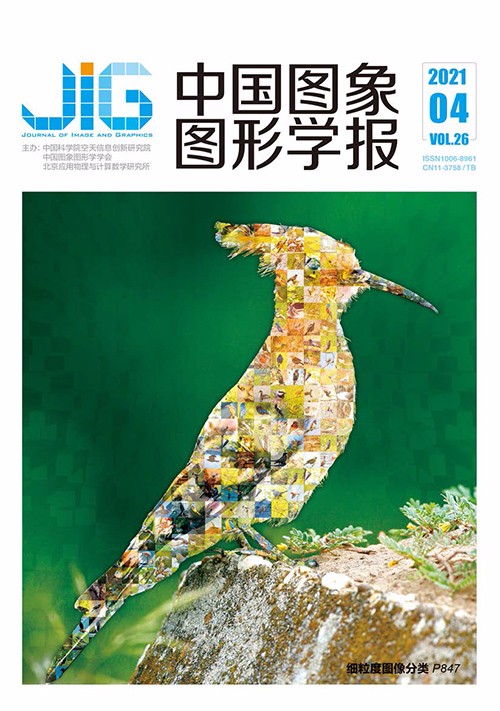
可变半径Alpha Shapes提取机载LiDAR点云建筑物轮廓
伍阳1, 王丽妍2, 胡春霞2, 程亮3(1.中国电子科技集团公司第二十八研究所, 南京 210007;2.南京市测绘勘察研究院股份有限公司, 南京 210019;3.南京大学江苏省地理信息技术重点实验室, 南京 210023) 摘 要
目的 机载激光雷达(light detection and ranging,LiDAR)能够快速获取建筑物表面的3维点云,为提取建筑物轮廓提供重要的数据支撑,但由于激光脚点的随机性和点云自身的离散性,常规固定半径Alpha Shapes(A-Shapes)算法难以兼顾轮廓提取的精细度和完整度,且在点数量较大情况下计算效率较低。因此,提出一种基于网格的可变半径Alpha Shapes方法用于提取机载LiDAR点云建筑物轮廓。方法 对3维点云进行投影降维,对投影后2维离散点的范围构建规则格网,接着根据网格内点云填充情况筛选出边界网格,计算边界网格的平滑度并加权不同的滚动圆半径,再以边界网格为中心生成3×3邻域网格检测窗口,利用滚动圆原理提取窗口内点集的边界点,迭代检测直到所有边界网格遍历完成,最后获取点云的完整轮廓。结果 在精度评价实验中,与固定半径A-Shapes方法和可变半径Alpha Shapes(variable radius Alpha Shapes,VA-Shapes)方法相比,若建筑物以直线特征为主且边缘点云参差不齐,则本文方法的提取效果不理想;若建筑物含有较多拐角特征,则本文方法的提取效果较好。在效率评价实验中,与A-Shapes方法、VA-Shapse方法以及包裹圆方法相比,若点云数据量较小,则4种方法的耗时差距不大;若数据量较大,则本文方法和包裹圆方法的耗时远小于固定半径A-Shapes方法。实验结果表明,本文提出的轮廓提取方法适用于多种形状的建筑物点云。从轮廓完整性、几何精度以及计算效率等几方面综合考虑,本文方法提取建筑物点云轮廓效果较好。结论 本文提出的基于网格的可变半径Alpha Shapes建筑物点云轮廓提取方法结合了网格划分和滚动圆检测的优点,能够有效提取机载LiDAR建筑物点云顶部轮廓,具有较高的提取效率和良好的鲁棒性,提取的轮廓精度较高。
关键词
Extraction of building contours from airborne LiDAR point cloud using variable radius Alpha Shapes method
Wu Yang1, Wang Liyan2, Hu Chunxia2, Cheng Liang3(1.The 28 th Research Institute of China Electronics Technology Group Corporation, Nanjing 210007, China;2.Nanjing Institute of Surveying Mapping&Geotechnical Investigation. Co. Ltd., Nanjing 210019, China;3.Jiangsu Provincial Key Laboratory of Geographic Information Science and Technology, Nanjing University, Nanjing 210023, China) Abstract
Objective Buildings are major spatial elements in urban areas, and 3D building models are significant for construction of intelligent cities. Airborne light detection and ranging (LiDAR) has the advantages of low operation cost, fast acquisition, and all-weather access to the point cloud with high accuracy. As a high-quality data source, the airborne LiDAR point cloud provides convenience for building extraction, feature recognition, and 3D model reconstruction. Extracting accurate and complete building contours from the point cloud is important. However, due to the dispersion and randomness of scanning point, it is hard to balance the contour accuracy and completeness by using conventional fixed radius Alpha Shapes (A-Shapes) algorithm in extracting point cloud building contours. Moreover, in the case of large amount of data, the computational efficiency is relatively low, and the detection is time-consuming. The boundary extraction algorithm of variable rolling circle radius based on 2D grids is proposed to extract the rooftop contour of airborne LiDAR data of buildings. Method The proposed method consists of several steps. First, the origin point cloud is projected to the 2D plane, and a 2D grid structure is obtained by dividing the entire point cloud into the regular grid net. Boundary grids that contain LiDAR points can be selected by conducting 8-neighborhood detection. Then, the smoothness of each boundary grid can be calculated by using the connect line of the gravity center of discrete points in each grid. On the basis of the smoothness of the boundary grid, the multi-level radius value of the rolling circle can be determined adaptively. The 3×3 grid detection window should be generated according to the boundary grid. Moreover, all points in the detection window can be detected by using the rolling circle principle of Alpha Shapes algorithm, and the boundary points in the detection windows can be extracted according to the moving track of the rolling circle. The detection window is iteratively moving one by one along the boundary grids to extract the boundary of the point cloud until all boundary grids are detected. Finally, all boundary points can be extracted. Result We select the airborne LiDAR point cloud data in the urban area, which contains diverse types of buildings, to analyze the accuracy and efficiency of the proposed method. Several methods, including the proposed method, the fixed radius A-Shapes method, the adaptive radius variable Alpha Shapes (VA-Shapes) method, and the pack circle method, are implemented in the same platform to compare the reliability and efficiency of extracting contour from point clouds. In the contrast experiment, the proposed method can rapidly extract the contour of the point cloud for T-shaped building. However, if the target building is straight and the edge point cloud is irregular, the contour extracted by the proposed method is not ideal. The boundary points extracted by the pack circle method are usually redundant, and the fixed radius A-Shapes method needs to adjust parameters manually many times to obtain a suitable result. For back-shaped building, the fixed radius A-Shapes method and adaptive radius VA-Shapes method easily ignore the corner and other details, whereas the proposed method has the ability to extract small features, including corners and bulges, of the building. For annular sector-shaped building, the proposed method, fixed radius A-Shapes method, and adaptive radius VA-Shapes method can extract the inner and outer contour of the point cloud effectively; however, the pack circle method cannot easily detect the inner contour. In summary, the pack circle method is the most efficient, followed by the proposed method. The fixed radius Alpha Shapes method takes the most time. If the radius of the rolling circle in the fixed radius A-Shapes method is too large, the rectangular feature of the contour can be easily smoothed. When the radius of the rolling circle is too small, the extracted contour is incomplete or even wrong. For the pack circle method, the boundary points can be extracted correctly and effectively only when the detection radius and the number threshold of points are both suitable. For overall consideration, compared with the fixed radius A-Shapes method, adaptive radius VA-Shapes method, and pack circle method, the proposed method can reduce the calculation time effectively on the basis of ensuring the effect of boundary extraction and has better robustness and accuracy. Conclusion In this study, we proposed the variable radius Alpha Shapes algorithm, which combines the advantages of grid generation and rolling circle detection. The experiment shows that our method can extract the complete contour of the building point cloud, with low complexity, high accuracy, and good robustness.
Keywords
|



 中国图象图形学报 │ 京ICP备05080539号-4 │ 本系统由
中国图象图形学报 │ 京ICP备05080539号-4 │ 本系统由